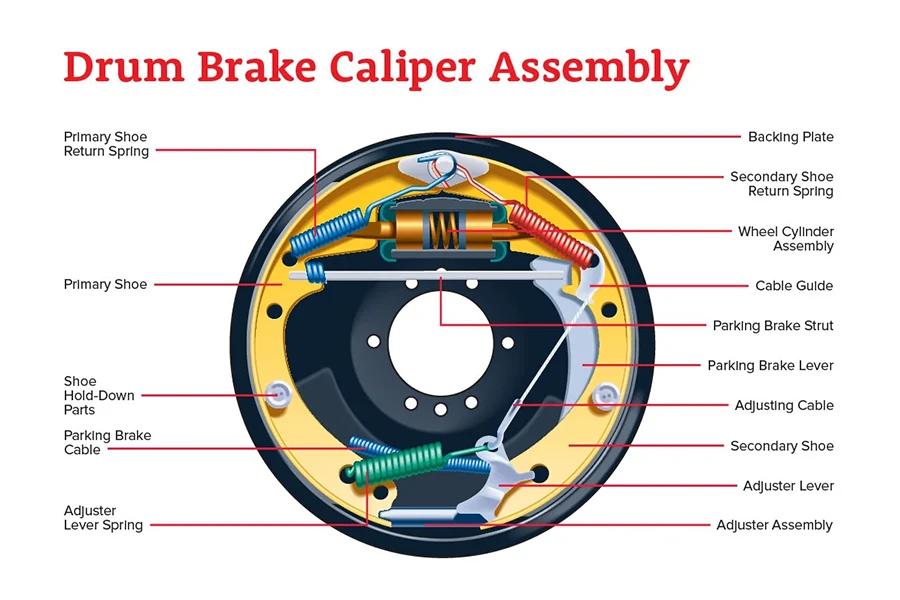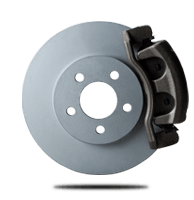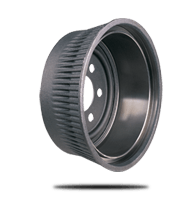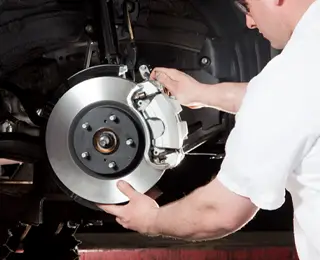Understanding Brake Shoes vs. Brake Pads
Safe driving is more than just knowing the rules of the road. It’s also having a good set of tires and properly functioning brakes. An important part of your brakes includes either brake pads or brake shoes. Let’s take a quick look at the two main braking systems as well as the differences between brake shoes and brake pads when it comes to your safety on the road.

What Are Brake Shoes?
Brake shoes are crescent-shaped metal parts with a friction lining on one side that provide stopping power for drum brakes. When you press on the brake pedal, pistons in drum brakes push the brake shoes out against the inside of the spinning drum. This resistance slows down the vehicle.
As brake shoes wear down due to friction, they need to be replaced to maintain braking performance. Overall, drum brakes and brake shoes are only found on the rear axle of some of today’s vehicles. They can also be found on many trailers.
Brake Shoes vs. Brake Pads
Disc brakes use brake pads that press against a rotor when you apply pressure to the brake pedal. In most models, drum brakes include a curved shoe that presses against a hollow drum. These are most often used on the rear wheels.
When working properly, both brake shoes and brake pads are designed to help slow down and bring your vehicle to stop when you apply the brakes. While both options provide stopping power, disc brakes have become the preferred braking system on today’s vehicles.
A few of the key differences between brake shoes and brake pads include:
- Brake shoes cost less than brake pads. But there are more parts to service in a set of drum brakes.
- Disc brakes have better stopping power than drum brakes. But brake pads can often wear down faster than brake shoes.
How to Tell What Braking System Your Car Uses
Start with your vehicle owner’s manual, or stop by Les Schwab. Our professionals can tell you what kind of brakes you have and even give them a visual inspection.
To figure out what kind of brakes you have, look behind the rims (wheels) on the front and rear of your vehicle.


Comparing Braking Systems
Comparing brake pads to brake shoes comes down to a few important features. Those include the components, how they work, heat distribution, overall performance, and maintenance needs.
- Disc brakes push brake pads against a spinning disc, while drum brakes press a shoe against the inside of a drum.
- Heat is an important factor in braking performance. Disc brakes dissipate heat better than drum brakes.
- Maintenance costs for both disc and drum brakes are about equal, with brake pads costing more than brake shoes. However, drum brakes have more parts to maintain and replace.
While there are benefits to both disc and drum brakes, the manufacturer of your vehicle has installed the proper brake configuration for your year, make and model. Changing from one type of brakes to another (from disc to drum, or drum to disc) is not recommended and may void your warranty.
Direction of Braking Force
The biggest difference between brake pads and brake shoes is how they bring your vehicle to a stop. Disc brakes squeeze a set of brake pads against a spinning rotor to stop the wheels from spinning. Drum brakes push outward against the inside of a drum to slow the axle and wheel.
Stopping Power and Efficiency
When properly maintained, both brake shoes and brake pads provide sufficient stopping power to help keep you and your family safe. The brake configuration on your vehicle is designed for optimum performance by the manufacturer.
Durability and Life Expectancy
Durability and life expectancy are where drum brakes and brake shoes shine. Overall, drum brakes and brake shoes will last longer than brake pads and disc brakes before requiring servicing. That longevity is thanks to the enclosed design of drum brakes. The enclosure protects the brake shoes and other parts from dirt, dust, and moisture.
However, the lifespan of your brakes depends on your driving habits, daily commute, and where you get your brakes checked and serviced. Les Schwab uses only the best brake components. Plus, we’ve been servicing brakes for decades.
Maintenance and Service
Both disc and drum brakes require regular maintenance and service. On disc brakes, the brake rotors and brake pads are easily accessible after removing the wheel and tire assembly. When servicing drum brakes, some additional level of expertise may be necessary to access, open, and maintain the internal parts. Maintaining both disc and drum brakes is easy when you go to Les Schwab. Stop by your nearby store for a visual brake inspection and recommendations for your safety.
When to Replace Brake Shoes and Pads
Anytime you notice vibrations in your steering wheel or pull when braking, it may be time to get into Les Schwab for a quick look. Additionally, squealing, squeaking or grinding sounds coming from your brakes, or bad smells, could indicate the need for new brake pads or brake shoes. Check out our guide to brake servicing for more information.
Les Schwab: Your Partner in Brake Maintenance
Get your brakes serviced and replaced right the first time at Les Schwab. We go the extra mile, providing visual brake checks, complete brake servicing and replacement, as well as brake fluid exchange. While some shops might do the bare minimum, we service the full system with comprehensive expertise, unmatched service, and quality parts. That includes our best brake value promise, which covers both parts and labor honored at every Les Schwab location.
What you need to know

Complete Guide to Disc Brakes and Drum Brakes
Everything you need to know about disc and drum brakes: why discs go on the front axle and drums on the rear, the advantages of each and what needs maintenance.

8 Signs You Could Have Brake Problems
The brakes on your vehicle are one of your most important safety features. Here are 8 signs to watch for and how to resolve brake problems.

Should You Replace All Four Pair of Brake Pads at Once?
Wondering if you should replace all four pair of brake pads at once? Learn the signs, benefits of simultaneous replacement, and expert tips for optimal performance.

